Most Popular Gods & Goddesses of Ancient China › Religion in Ancient China » Origins and History
Articles and Definitions › Contents
- Most Popular Gods & Goddesses of Ancient China › Antique Origins
- Religion in Ancient China › Antique Origins
Ancient civilizations › Historical places, and their characters
Most Popular Gods & Goddesses of Ancient China › Antique Origins
Ancient Civilizations
There were over 200 gods and goddesses worshipped throughout ancient China, but if one were to count every deity or spirit, the number would be over 1,000. Each town, village, city, field, farm, and sometimes even separate plot in a graveyard, had its own Tudi Gong, an elemental earth spirit, who was recognized and honored. There were also spirits known as Kuei-Shen, nature spirits, who might inhabit a tree or live by a stream or preside over a garden.
These were eternal spirits who had never been mortal but others, known as guei (or kuei, gui, kui ), had once been human beings who had died and passed on to the afterlife. The guei could return to haunt the living for various reasons, and rituals, spells, and religious practices developed to appease them. There were also deities who had once been mortal and now lived with the gods, such as the Baxian ( Pa Hsien ), the Eight Immortals of holy Taoists who were rewarded by the goddess Queen Mother of the West with immortality. The Baxian were prayed to like any of the other gods, as were one's ancestors who had passed over the bridge between the land of the living and the realm of the dead to live among the gods and watch over the living.
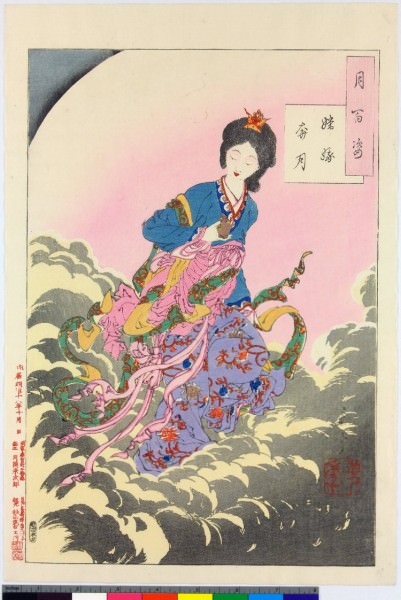
Chang E Flees to the Moon
The gods were believed to have created the world and human beings, and they kept the world and surrounding universe functioning. Each deity had his or her own special area of power and influence, and the most important were given their own shrines and temples, although shrines were also erected to local spirits and to noble men and women who became deified after death.
THE GODS WERE BELIEVED TO HAVE CREATED THE WORLD AND HUMAN BEINGS, AND THEY KEPT THE WORLD AND SURROUNDING UNIVERSE FUNCTIONING.
These deities lived in palaces and castles high above human beings in places like the Kunlun Mountains, Mount Tai, the Jade Mountain, and Mount Penglai which was the mystical island of the afterlife somewhere far out at sea. Even though they were far away, they were still connected to human life on a daily basis, watching over and keeping account of the good and bad deeds people did. Each of the deities had their own part to play in the lives of people and the operation of the world from the most intimate moments to events of national importance such as a dynasty's collapse.
All of the gods, goddesses, and spirits were important to the people of ancient China, and remain so today, and selecting a certain small group leaves out many, many others who remain just as significant. However, one can single out those deities who had national prominence, are among the oldest, or are without question the most popular as shown through ancient writings and evidence from archaeological excavations. The gods and goddesses listed below are given in the order they appear in Chinese writings. Most likely, deities like Nuwa, Fuxi, and P'an Ku were recognized much earlier than written records indicate, and the same is probably true of most of the gods and goddesses on the list. These deities are selected because they were all very important to the people of ancient China even though some were more prominent at certain times in history than at others.
DRAGON
The dragon is the oldest symbol of a deity found in China. The dragon symbol appears on pottery found at the Neolithic site of Banpo Village dating from between c. 4500-3750 BCE. Dragon was considered a composite of yin and yang energies and was originally seen as a balancing force who was wise and just. The dragon Yinglong was known as The Dragon King and god of rain and waters. As god of the sea, he was known as Hong Shen and was prayed to regularly by sailors and fishermen, but farmers who needed rain for their crops worshipped Dragon as well. He is also shown in human form as a wise man with the full sun behind his head watching over a boat full of people.
SHANGTI
Shangti was the supreme god of law, order, justice, and creation. He is also known as Jade Emperor, Yellow Emperor, or Yu Huang Shang-Ti, although there are sometimes important distinctions made between these names and Jade Emperor can mean another deity. Shangti was considered the great ancestor of all Chinese, who gave the people culture, architecture, skill in battle, agriculture, controlled the weather, regulated the seasons, and was king over the other gods, human beings, and nature. He was worshipped primarily during the Shang Dynasty (1600-1046 BCE) when he was considered a deified king who ruled c. 2697-2597 BCE and was included in the mythical or semi-mythical grouping of the Three Sovereigns and Five Emperors, demi-gods who ruled China between c. 2852-2070 BCE. During the Zhou Dynasty (c. 1046-226 BCE) Shangti was replaced by the concept of Tian (Heaven) but re-emerged as Shangti during the Warring States Period (476-221 BCE). The Zhou developed the concept of the Mandate of Heaven which legitimized the rule of a certain dynasty. Tian judged who was worthy to rule and for how long, and when a dynasty was no longer fit, it fell and another took its place.
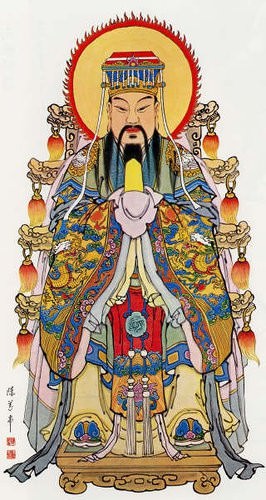
The Jade Emperor
QUEEN MOTHER OF THE WEST
She was the queen of the immortal gods and spirits, especially female spirits who lived in the mystical land of Xihua ("West Flower"), and goddess of immortality. She is also known as Xiwangmu or Xi-Wang-Mu and lived in a castle of gold in the Kunlun Mountains, surrounded by a moat which was so sensitive that even a hair dropped on the waters would sink. This moat served as protection for her Imperial Peach Orchard where the juices of the fruit of the trees gave immortality. Xiwangmu is shown as a beautiful woman with sharp teeth and a leopard's tail, or as an old, unattractive woman with a hunched back, tiger's teeth and a leopard's tale, depending on her mood. She rewarded her followers with eternal life but punished those who angered her. During the Han Dynasty (206 BCE-220 CE) her cult was very popular and shrines were built for her by the government. She is the wife of Mugong, Lord of the Spirits, who watches over male spirits in the land of Donghua ("East Flower") but is sometimes seen as the wife of Shangti.
GUANYIN
Guanyin was the goddess of mercy and compassion who became the patron of sailors and fishermen. She was originally a deity in India known as Avalokitesvara whose name means "One Who Gazes Down Upon the World and Hears the Cries of the People". She came to China from India through trade via the Silk Road during the Han Dynasty (206 BCE-220 CE). She was so compassionate that she incarnated as the maiden Miaoshan in order to experience life as a human being and offer service to others. Miaoshan's father wanted her to marry a wealthy priest. Miaoshan refused to marry unless the marriage could end the sufferings caused by illness, aging, and death. When her father told her no marriage could end such things, she replied that a doctor could, but her father did not want her marrying someone of such a lowly occupation. She was allowed to enter a temple instead of marrying, but her father made sure that she was given all of the worst work, which she accomplished with the help of the nearby animals who responded to her goodness. Her father then tried to burn the temple down but Miaoshan put the fire out with her bare hands. He then had her executed, but when she went to hell, she released all of the goodness she held inside and turned it into paradise. The king of the dead, Lord Yama, sent her back to earth before she ruined his realm, and she lived afterwards on Fragrant Mountain where she watched over human beings. From her mountain home, she would often notice people in trouble on their boats at sea and rescued them, which is how she became patron goddess of sailors and fishermen. She was one of the most popular deities in all of China, and both men and women adored her.
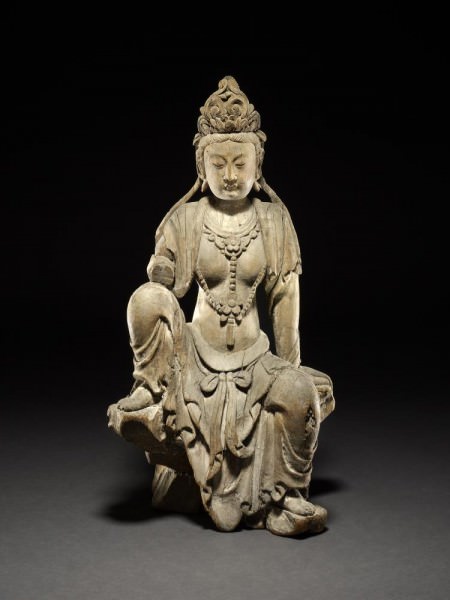
Guanyin
YAN WANG
Yan Wang is the god of death and king in the afterlife. He is the greatest of all the Lords of Death who rule the regions of the underworld. He is also known as Yang-Wang-Yeh, Lord Yama, and Lord Yama King. Yan Wang presides over the judgment of souls and decides whether they will be punished for their crimes in life, go on to live with the gods, or be reincarnated. In one famous story, a soldier named Commandant Yang, who had caused a great deal of suffering and misery in his life, died and appeared in the court of Yan Wang. Yan Wang asked him how he had managed to build up so many sins on his soul in the short time he was on earth. Yang claimed he was innocent and had done nothing wrong. Yan Wang commanded the scrolls of Yang's life to be brought in where the date and time of his sins were read along with who was affected and how many had died because of Yang's selfishness. Yang was condemned by the Lord of Death, and a great hand appeared which snatched him up and crushed him. It was said that one could escape punishment for one's sins on earth but no one could escape justice in the court of Yan Wang.
NUWA & FUXI
Nuwa and Fuxi were the mother and father deities of human beings. Nuwa was born at the beginning of creation and fixed the mistakes made at first so that everything was perfect. She built a palace for herself, which became the model for Chinese architecture, and lived there with her friend and brother Fuxi, both depicted as human-dragons with human heads and dragon bodies or human bodies to the waist and dragon legs and tails. Nuwa became lonely and created human beings for company from the mud of the Yellow River. She breathed life into them and they moved and lived. She continued to make more and more human beings but it was tiring work and so she created marriage so that they could reproduce themselves.The humans were alive but had no knowledge of anything and so Fuxi gave them the gifts of fire, writing, how to get food from the sea, and all the other skills they would need to live. He also gave them the gifts of music, culture, and divination so they could make good decisions by knowing what the future held.
CAISHEN
Caishen, the god of wealth, was one of the most popular gods of ancient China and still is today. Statues of Caishen (also known as Ts'ai Shen) can be seen in businesses run by Chinese merchants all around the world and in Chinese homes. His statue shows a wealthy man seated in a silk robe holding riches in both hands. He is sometimes accompanied by two attendants carrying bowls of gold. He was not just the god of material wealth but of a rich life which meant a happy family and a secure, prosperous, and respectable job. Caishen was very generous to his followers but was not foolish and did not give out his wealth to just anyone. People had to prove themselves worthy of his generosity by working hard, praying to him regularly, and thanking him for his gifts. Temples and shrines to Caishen were probably the most numerous in ancient China.
CHANG'E
Chang'e, the goddess of the moon, was another of the most popular deities in ancient China and is the most often mentioned deity in Chinese poetry and literature. She was the consort of the archer god Hou Yi who saved her during a lunar eclipse and brought her back safely. Chang'e betrayed him by stealing from him the elixir of immortality, which the gods had given him, and ran across the night sky with it, pursued by Hou Yi. She reached the moon where she transformed herself into a toad to hide from him until his rage passed. Hou Yi had been stopped in his pursuit by a hare who would not let him pass until he calmed down and promised he would not harm her. When Hou Yi reached the moon, Chang'e had remained in her toad form too long to change back and so, when one looks at the moon, one sees the outline of a toad on its surface. The story of Chang'e and Hou Yi was celebrated at the Mid-Autumn Festival in ancient China which is known today as the Moon Festival when people go outside at night to appreciate the moon, eat moon cakes, and give gifts to friends and family.
ZAO-SHEN
Zao-Shen (or Tsao Shen and Tsao Wang), also known as The Kitchen God, lived in the kitchen above the stove of every home. He was represented by a paper image made by the most prestigious woman of the household and was kept in the same place throughout the year. Zao-Shen was responsible for the happiness of the home and the prosperity of the family, but this depended on their behavior and values. Every month Zao-Shen left the home to report to the local gods and spirits on the family's conduct. If they had behaved well, he was instructed to increase their riches and happiness; if they had behaved badly, he was told to withdraw riches and happiness. "Riches" meant not only material wealth but comfort and well-being, which was further assured by his warding off evil spirits. When he left the home to make his report, families were especially anxious because they had no household protector. At the end of the lunar year, on New Year's Eve, Zao-Shen had to leave to report to Shangti himself and the universal gods on how the family had behaved throughout the year. At this time, more incense was burned than usual in front of the paper statue and its mouth was smeared with honey so that only sweet words about the family would be reported to the gods. Offerings of fine foods and good wine were placed before him to thank him for his protection. The paper figure was then burned and firecrackers set off to speed him on his way. The next morning, the first day of the New Year, a new paper statue was made and placed above the stove.
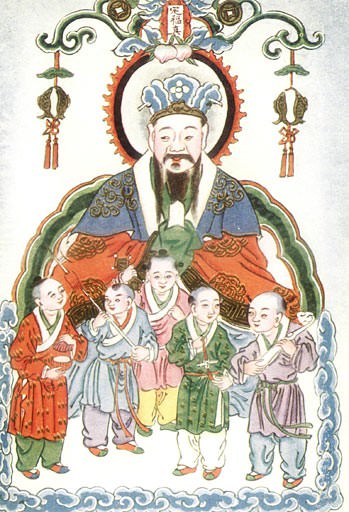
Zao-Shen, the Kitchen God
NIU LANG & ZHI NU
The god and goddess of love. Zhi Nu was the goddess of weaving for the gods and daughter of Shangti. Every day she wove the beautiful robes the gods wore and looked down on earth from her place among the stars and wished she could visit. She was finally granted permission by her father and went to earth where she left her clothes by the banks of a stream and went swimming. A cowherd named Niu Lang saw her and fell in love with her so he stole her clothes so she could not run away from him. When Zhi Nu came out of the water she was outraged that her clothes were gone but when Niu Lang explained himself she fell in love with him. She forgot all about her home in the heavens and her duties as divine weaver and stayed on earth with Niu Lang. They were very happy together, every day they were more in love, and they had many children. Shangti was not pleased, though, and neither were the other gods and so soldiers were sent to bring Zhi Nu back home. Niu Lang tried to follow but Shangti threw a wall of stars across his path and stopped him; these stars are known on earth as the Milky Way.Once a year, magpies fly from earth to the Milky Way and form a bridge the two can cross to be with each other on the evening known as the Seventh Night of the Seventh Moon. This became a very popular story referenced by writers and poets in many different eras of China's history. The Lady in the famous poem, Song of Everlasting Sorrow, references this story toward the end when she is on the island in the afterlife. The myth was the basis for the Festival of the Seventh Night of the Seventh Moon which officially was dedicated to women's art in sewing and weaving but unofficially was a night for romance. Zhi Nu is the star Vega in the constellation of Lyra, and Niu Lang is the star Altair in the constellation of Aquila, separated by the Milky Way except for once a year.
MENSHEN
Menshen, the guardians of the door, known as "Gods of Peaceful Sleep" who protect a room, house, or building from evil spirits and ghosts, originated in the early Tang Dynasty (618-901 CE). The emperor Taizong (626-649 CE) was having a hard time sleeping because of nightmares. He consulted a doctor who blamed the bad dreams on evil spirits. Taizong's nightmares were so real he thought people were actually in the room trying to kill him, and so two of his most trusted guards were posted outside the door of his room, one standing on each side. Taizong began to sleep better with the guards outside and so ordered that their images be painted on the doorway. News of Taizong's painted soldiers spread and soon more and more people were painting guardians on their doors and rooms. These images can be seen on many buildings and homes in China and elsewhere. Part of the Chinese New Year celebration is cleaning and re-painting the Menshen on doorways.
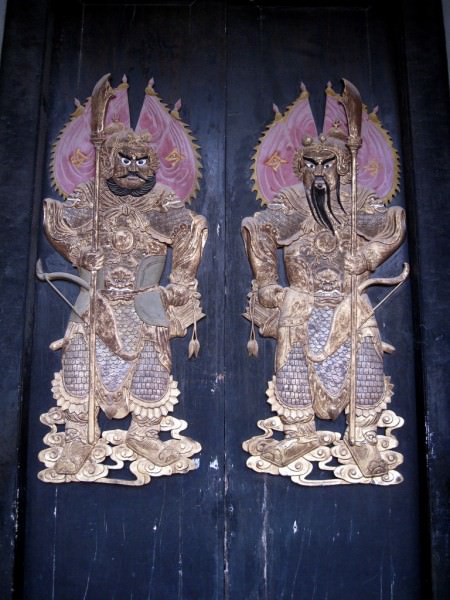
Chinese Door Gods
P'AN KU
The god of creation, P'an Ku (also known as Pan Gu and Pangu) is pictured as a hairy dwarf with horns. Once there was only darkness everywhere in the universe and in this grew a cosmic egg which was kept warm for thousands of years until it broke open and P'an Ku appeared. He cut through the darkness and separated the yin from the yang principles; then he made the yin into earth and the yang into sky and pushed them apart from each other. Every day he stood on the earth and pushed the sky a little higher, and each day he grew taller and taller until he was a giant. P'an Ku then began to add pretty details to his creation like mountains and valleys, which he made according to the principles of yin and yang so that everything would be balanced. He worked on his creation for thousands of years until it was perfect, and then he died. His breath became air and his blood the rivers and streams. The fleas from his body ran off and became animals while his body hair became forests of trees and bushes. His left eye became the sun and his right eye the moon. Many centuries after his death, Nuwa appeared and created human beings and Fuxi taught them how to survive in the world P'an Ku had created. In another version of the myth, human beings are the fleas which run from P'an Ku's body after he dies.
OTHER GODS & GODDESSES
These gods and goddesses and many others were worshipped by the Chinese people for centuries. Some developed later than others but all were important to the people. There were many other notable gods who deserve mention: Guan Gong (also known as Guandi), the god of war, who was a great warrior and hero deified after his death; Sun Wukong, the god of mischief, who ate the peaches of immortality and tricked the gods into giving him eternal life; Fu-Shen, the god of happiness;Hou-Ji, god of Millet and grains; Kailushen, "Spirit Who Clears Roads", a protector against ghosts and evil spirits; Sheji, god of soil and grain, a harvest fertility god; Wen Chang (also known as Wendi), god of literature who was the patron of scholars and writers and kept accounts of how well writers used their talents in life; and Cheng Huang, "God of Wall and Moat" who protected the walls and gates of the cities. Although worship of these gods was outlawed as "superstition" when the communist party took control of the Chinese government in 1949 CE, they continued to be worshipped privately by the people and are still honored in many homes all over the world today.
Religion in Ancient China › Antique Origins
Ancient Civilizations
Religious practices in ancient China go back over 7,000 years. Long before the philosophical and spiritual teachings of Confucius and Lao-Tzu developed or before the teachings of the Buddha came to China, the people worshipped personifications of nature and then of concepts like "wealth" or "fortune" which developed into a religion. These beliefs still influence religious practices today. For example, the Tao te Ching of Taoism maintains that there is a universal force known as the Tao which flows through all things and binds all things but makes no mention of specific gods to be worshipped; still, modern Taoists in China (and elsewhere) worship many gods at private altars and in public ceremonies which originated in the country's ancient past.
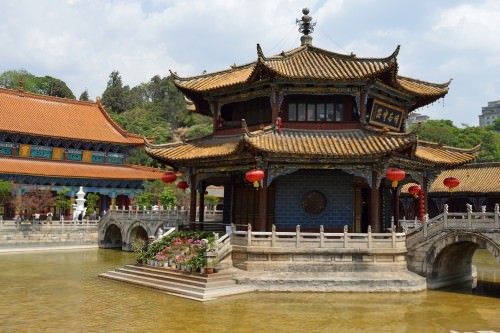
Yuantong Temple
Scholar Harold M. Tanner writes, "The gods, spirits, and ancestors could affect crops, the weather, childbirth, the king's health, warfare, and so on. It was, therefore, important to sacrifice to them" (43). The gods grew out of people's observance of natural phenomena which either frightened them and caused uncertainty or assured them of a benevolent world, which would protect them and help them succeed. As time passed, these beliefs became standardized and the gods were given names and personalities, and rituals developed to honor the deities. All of these practices were eventually standardized as "religion" in China just as similar beliefs and rituals were everywhere else in the ancient world.
EARLY EVIDENCE OF RELIGIOUS PRACTICE
In China, religious beliefs are evident in the Yangshao Culture of the Yellow River Valley, which prospered between 5000-3000 BCE. At the Neolithic site of Banpo Village in modern Shaanxi Province (dated to between c. 4500-3750 BCE) 250 tombs were found containing grave goods, which point to a belief in life after death. There is also a ritualistic pattern to how the dead were buried with tombs oriented west to east to symbolize death and rebirth. Grave goods provide evidence of specific people in the village who acted as priests and presided over some kind of divination and religious observance.
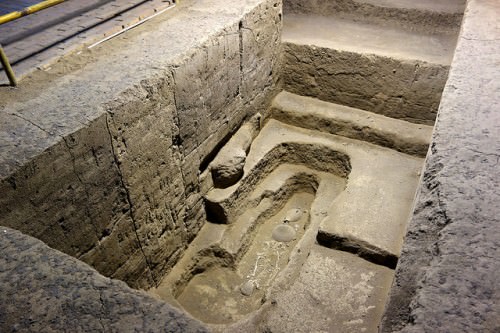
Banpo Village Tomb
The Yangshao Culture was matrilineal, meaning women were dominant, so this religious figure would have been a woman based on the grave goods found. There is no evidence of any high-ranking males in the burials but a significant amount of females. Scholars believe that the early religious practices were also matrilineal and most likely animistic, where people worship personifications of nature, and usually feminine deities were benevolent and male deities malevolent, or at least more to be feared.
These practices continued with the Qijia Culture (c. 2200-1600 BCE) who inhabited the Upper Yellow River Valley but whose culture could have been patriarchal. Examinations of the Bronze Age site of Lajia Village in modern-day Qinghai Province (and elsewhere) have uncovered evidence of religious practices. Lajia Village is often referred to as the "Chinese Pompeii " because it was destroyed by an earthquake which caused a flood and the resulting mudslides buried the village intact. Among the artifacts uncovered was a bowl of noodles which scientists have examined and believe to be the oldest noodles in the world and precursors to China's staple dish "Long-Life Noodles". Even though not all scholars or archaeologists agree on China as the creator of the noodle, the finds at Lajia support the claim of religious practices there as early as c. 2200 BCE.There is evidence that the people worshipped a supreme god who was king of many other lesser deities.
GHOSTS & RELIGION
By the time of the Shang Dynasty (1600-1046 BCE) these religious beliefs had developed so that now there was a definite "king of the gods" named Shangti and many lesser gods of other names. Shangti presided over all the important matters of state and was a very busy god. He was rarely sacrificed to because people were encouraged not to bother him with their problems. Ancestor worship may have begun at this time but, more likely, started much earlier.
Evidence of a strong belief in ghosts, in the form of amulets and charms, goes back to at least the Shang Dynasty and ghoststories are among the earliest form of Chinese literature. Ghosts (known as guei or kuei ) were the spirits of deceased persons who had not been buried correctly with due honors or were still attached to the earth for other reasons. They were called by a number of names but in one form, jiangshi ("stiff body"), they appear as zombies. Ghosts played a very important role in Chinese religion and culture and still do. The ritual still practiced in China today known as Tomb Sweeping Day (usually around 4 April) is observed to honor the dead and make sure they are happy in the afterlife. If they are not, they are thought to return to haunt the living. The Chinese visit the graves of their ancestors on Tomb Sweeping Day during the Festival of Qingming, even if they never do at any other time of the year, to tend the graves and pay their respects.
When someone died naturally or was buried with the proper honors, there was no fear of them returning as a ghost. The Chinese believed that, if the person had lived a good life, they went to live with the gods after death. These spirits of one's ancestors were prayed to so they could approach Shangti with the problems and praise of those on earth. Tanner writes:
Ancestors were represented by a physical symbol such as a spirit tablet engraved or painted with the ancestor's honorific name. Rituals were held to honor these ancestors, and sacrifices of millet ale, cattle, dogs, sheep, and humans were offered. The scale of the sacrifices varied, but at important rituals, hundreds of animals and/or human sacrifices would be slaughtered. Believing that the spirits of the dead continued to exist and to take an interest in the world of the living, the Shang elite buried their dead in elaborate and well-furnished tombs (43).
The spirits of these ancestors could help a person in life by revealing the future to them. Divination became a significant part of Chinese religious beliefs and was performed by people with mystical powers (what one would call a "psychic" in the modern day) one would pay to tell one's future through oracle bones. It is through these oracle bones that writing developed in China. The mystic would write the question on the shoulder bone of an ox or turtle shell and apply heat until it cracked;whichever way the crack went would determine the answer. It was not the mystic or the bone which gave the answer but one's ancestors who the mystic communed with. These ancestors were in touch with eternal spirits, the gods, who controlled and maintained the universe.
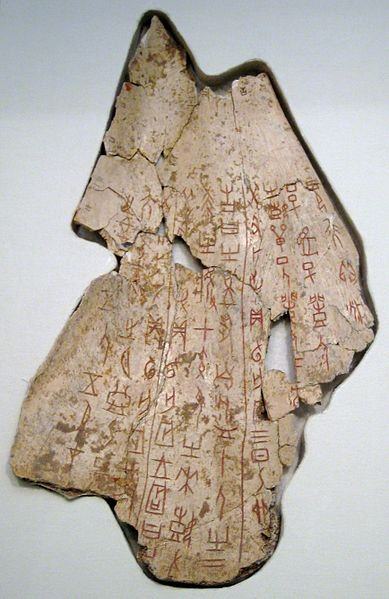
Chinese Oracle Bone
THE GODS
There were over 200 gods in the Chinese pantheon whose names were recorded during and after the Shang Dynasty. The early gods, before Shangti, were spirits of a place known as Tudi Gong ("Lord of the Place" or "Earth God"). These were earth spirits who inhabited a specific place and only had power in that locale. The Tudi Gong were sometimes thought to be an important member of the community who had died but remained in spirit as a guardian but, more often, they were ancient spirits who inhabited a certain area of land. These spirits were helpful if people acknowledged and honored them, and vengeful if they were ignored or neglected. The Chinese concept of Feng Shui comes from the belief in the Tudi Gong.
These local earth spirits continued to be venerated even after gods developed who were more universal. One of the first deities acknowledged who probably began as a local spirit was the dragon. The dragon is one of the oldest gods of China.Dragon images have been found on the Neolithic pottery at Banpo Village and other sites. The Dragon King known as Yinglong was god of rain, both gentle rain for the crops and terrible storms, also as Lord of the Sea and protector of heroes, kings, and those who fought for right. Dragon statuary and imagery is routinely used in Chinese art and architecture to symbolize protection and success.
THERE WERE OVER 200 GODS IN THE CHINESE PANTHEON WHOSE NAMES WERE RECORDED DURING AND AFTER THE SHANG DYNASTY. ABOVE ALL WAS SHANGTI, THE GOD OF LAW, ORDER, JUSTICE, AND LIFE, KNOWN AS "THE LORD ON HIGH".
Some form of Nuwa, goddess of humankind, existed as early as the Shang Dynasty. Nuwa was a goddess part woman and part dragon who molded human beings from the mud of the Yellow River and blew her breath into them to bring them to life.She continued making people and bringing them to life over and over again but grew tired of it finally and invented marriage so people could reproduce without her. She saw that people did not know how to do anything, though, so she asked her friend Fuxi for help.
Fuxi is the god of fire and the teacher of human beings. He brought fire to people and taught them how to control it to cook food, bring light, and keep warm. Fuxi also wove the first fishing nets for the people and taught them how to get food from the sea. Once their basic needs were taken care of, he gave them the gifts of music, writing, and divination. Nuwa and Fuxi were considered the mother and father of human beings and always were called on for protection.
Sun Wukong was the monkey god of mischief who caused so much trouble he was killed by the other gods and sent to the underworld. Once he got there, he erased his name from the book of the king of the underworld and not only came back to life but could never die again. His name did not develop until later but a mischevious monkey god appears on bronze inscriptions from the Shang Dynasty who appears to be this same deity.
Lei Shen was the god of thunder who was very unpleasant and beat on a large drum with a hammer whenever he became irritated. He could not tolerate anyone who wasted food and would hurl thunderbolts at them, killing them instantly. One time, he saw a woman who seemed about to throw out a bowl of rice and killed her with his thunderbolt. The gods determined that he had acted too quickly and so the woman, Dian Mu, was raised from death and became the goddess of lightning. She would flash her light to show Lei Shen where he should throw his thunderbolts so he would not make the same mistake again.
Above these gods and all the others was Shangti, the god of law, order, justice, and life known as "The Lord on High". Shangti decreed how the universe would run and the lives of all the people were under his constant watch. He was especially mindful of those who ruled over others and decided who should rule, how long, and who should succeed them.
WORSHIP & CLERGY
Chinese temples and shrines were cared for by priests and monks who were always male. Women were allowed to enter monasteries to devote themselves to the work of the gods but could not hold spiritual authority over men. Different types of religious services were held in temples for different religious beliefs. These services all had in common the sound of music, most often bells. The monastic prayers were said three times a day, at morning, noon, and night, to the sound of a small bell.Incense was burned regularly at services to cleanse the place of evil spirits and negative energies.
An important aspect of Chinese religion, whether Taoism, Confucianism, or Buddhism, was known as "hygiene schools" which instructed people on how to take care of themselves to live longer lives or even achieve immortality. Hygiene schools were part of the temple or monastery. The priests taught people how to eat healthy, exercise (the practice of Tai Chideveloped through these schools), and perform rituals honoring the gods so the gods would bless them with a healthy long life.
FURTHER RELIGIOUS DEVELOPMENTS
In the Zhou Dynasty (c. 1046-226 BCE) the concept of the Mandate of Heaven was developed. The Mandate of Heaven was the belief that Shangti ordained a certain emperor or dynasty to rule and allowed them to rule as long as they pleased him.When the rulers were no longer taking care of the people responsibly, they were said to have lost the Mandate of Heaven and were replaced by another. Modern scholars have seen this simply as a justification for changing a regime but the people at the time believed in the concept. The gods were thought to watch over the people and would pay special attention to the emperor.People continued a practice, which began toward the end of the Shang Dynasty, of wearing charms and amulets of their god of choice or their ancestors for protection or in the hope of blessings, and the emperor did this as well. Religious practices changed during the latter part of the Zhou Dynasty owing to its decline and eventual fall but the practice of wearing religious jewelry continued.
The Zhou Dynasty is divided into two periods: Western Zhou (1046-771 BCE) and Eastern Zhou (771-226 BCE). Chinese culture and religious practices flourished during the Western Zhou period but began to break apart during the Eastern Zhou.Religious practices of divination, ancestor worship, and veneration for the gods continued, but during the Spring and Autumn Period (772-476 BCE) philosophical ideas began to challenge the ancient beliefs.
Confucius (c. 551-479 BCE) encouraged ancestor worship as a way of remembering and honoring one's past but emphasized people's individual responsibility in making choices and criticized an over-reliance on supernatural powers. Mencius (c. 372-289 BCE) developed the ideas of Confucius, and his work resulted in a more rational and restrained view of the world. The work of Lao-Tzu (c. 500 BCE) and the development of Taoism might be seen as a reaction to Confucian principles if not for the fact that Taoism developed many centuries before the traditonal date assigned to Lao-Tzu. It is much more probable that Taoism developed from the original nature/folk religion of the people of China than that it was created by a 6th-century BCE philosopher. Therefore, it is more accurate to say that the rationalism of Confucianism probably developed as a reaction to the emotionalism and spiritualism of those earlier beliefs.
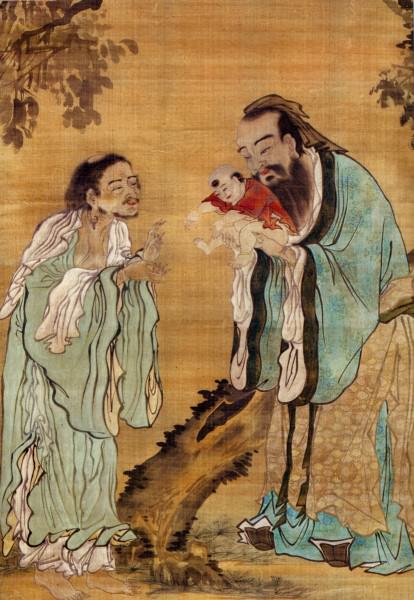
Confucius, Buddha and Lao-Tzu
Religious beliefs developed further during the next period in China's history, The Warring States Period (476-221 BCE), which was very chaotic. The seven states of China were all independent now that the Zhou had lost the Mandate of Heaven, and each one fought the others for control of the country. Confucianism was the most popular belief during this time, but there was another which was growing stronger. A statesman named Shang Yang (died 338 BCE) from the region of Qin developed a philosophy called Legalism which maintained that people were only motivated by self-interest, were inherently evil, and had to be controlled by law. Shang Yang's philosophy helped the State of Qin overpower the six other states and the Qin Dynastywas founded by the first emperor, Shi Huangti, in 221 BCE.
RELIGION BANNED AND REVIVED
During the Qin Dynasty (221-206 BCE), Shi Huangti banned religion and burned philosophical and religious works. Legalism became the official philosophy of the Qin government and the people were subject to harsh penalties for breaking even minor laws. Shi Huangti outlawed any books which did not deal with his family line, his dynasty, or Legalism, even though he was personally obsessed with immortality and the afterlife, and his private library was full of books on these subjects. Confucian scholars hid books as best as they could and people would worship their gods in secret but were no longer allowed to carry amulets or wear religious charms.
Shi Huangti died in 210 BCE while searching for immortality on a tour through his kingdom. The Qin Dynasty fell soon after, in 206 BCE, and the Han Dynasty took its place. The Han Dynasty (202 BCE-220 CE) at first continued the policy of Legalism but abandoned it under Emperor Wu (141-87 BCE). Confucianism became the state religion and grew more and more popular even though other religions, like Taoism, were also practiced.
During the Han Dynasty, the emperor became distinctly identified as the mediator between the gods and the people. The position of the emperor had been seen as linked to the gods through the Mandate of Heaven from the early Zhou Dynasty but now it was his express responsibility to behave so that heaven would bless the people. Mount Tai became an important sacred site during this time and ancient rituals and festivals were revised. An example of this would be the Festival of the Five Elements which honored earth, fire, metal, water, and wood which was changed to the Festival of Heaven and Earth, honoring the people's relationship with the gods.
An important religious sect which gained popularity during this time was the cult of the Queen Mother of the West, Xi Wang Mu, goddess of immortality. She lived in the mountains of Kunlun, like the other gods, but in a castle of gold, with a moat around it, so sensitive that anything, even a hair, which fell upon it would sink. She walked every day in her Imperial Peach Orchard whose fruit held the divine juices of immortality. Scholar Patricia Buckley Ebrey comments on this cult:
The Queen Mother of the West was sometimes represented as an old, unattractive woman with sharp teeth like a tiger's and a hunched back, and at other times as a beautiful woman with long hair. She jealously guarded the secrets of immortality in her garden and struck down people who tried to find their way in. She was kind to her followers, though, and blessed them as long as they pleased her.
THE ARRIVAL OF BUDDHISM
In the 1st century CE, Buddhism arrived in China via trade through the Silk Road. According to the legend, the Han emperor Ming (28-75 CE) had a vision of a golden god flying through the air and asked his secretary who that could be. The assistant told him he had heard of a god in India who shone like the sun and flew in the air, and so Ming sent emissaries to bring Buddhist teachings to China. Buddhism quickly combined with the earlier folk religion and incorporated ancestor worship and veneration of Buddha as a god.
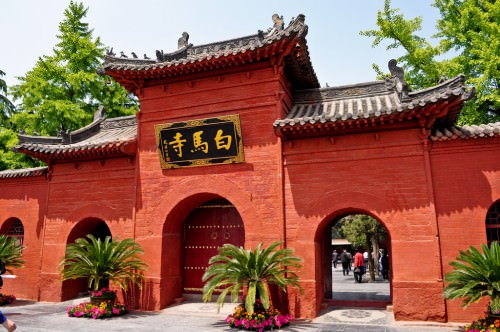
White Horse Temple
Buddhism was welcomed in China and took its place alongside Confucianism, Taoism, and the blended folk religion as a major influence on the spiritual lives of the people. When the Han Dynasty fell, China entered a period known as The Three Kingdoms (220-263 CE) which was similar to the Warring States Period in bloodshed, violence, and disorder. The brutality and uncertainty of the period influenced Buddhism in China which struggled to meet the spiritual needs of the people at the time by developing rituals and practices of transcendence. The Buddhist schools of Ch'an (better known as Zen), Pure Land, and others took on form at this time.
Buddhism introduced a new kind of ghost to China, the e gui ("Hungry Ghost"), which became one of the most feared. The modern day Ghost Festival in China (also known as the Hungry Ghost Festival) grew out of this belief. Hungry ghosts were spirits of those who had been murdered, improperly buried, or had sinned and not been forgiven. They could also be people who had never been satisfied with anything in life and were no happier in death. People would leave food out for them during Ghost Month to appease them and went to the graves of their ancestors to sacrifice food so they would not become hungry ghosts.
THE TANG DYNASTY & RELIGION IN CHINA
The major religious influences on Chinese culture were in place by the time of the Tang Dynasty (618-907 CE) but there were more to come. The second emperor, Taizong (626-649 CE), was a Buddhist who believed in toleration of other faiths and allowed Manichaeism, Christianity, and others to set up communities of faith in China. His successor, Wu Zeitian (690-704 CE), elevated Buddhism and presented herself as a Maitreya (a future Buddha) while her successor, Xuanzong (712-756 CE), rejected Buddhism as divisive and made Taoism the state religion.
Although Xuanzong allowed and encouraged all faiths to practice in the country, by 817 CE Buddhism was condemned as a dividing force which undermined traditional values. Between 842-845 CE Buddhist nuns and priests were persecuted and murdered and temples were closed. Any religion other than Taoism was prohibited, and persecutions affected communities of Jews, Christians, and any other faith. The emperor Xuanzong II (846-859 CE) ended these persecutions and restored religious tolerance. The dynasties which followed the Tang up to the present day all had their own experiences with the development of religion and the benefits and drawbacks which come with it, but the basic form of what they dealt with was in place by the end of the Tang Dynasty.
Confucianism, Taoism, Buddhism, and the early folk religion combined to form the basis of Chinese culture. Other religions have added their own influences but these four belief structures had the most impact on the country and the culture. Religious beliefs have always been very important to the Chinese people even though the People's Republic of China originally outlawed religion when it took power in 1949 CE. The People's Republic saw religion as unnecessary and divisive, and during the Cultural Revolution temples were destroyed, churches burned, or converted to secular uses. In the 1970's CE the People's Republic relaxed its stand on religion and since then has worked to encourage organized religion as "psychologically hygienic" and a stabilizing influence in the lives of its citizens.
LICENSE:
Article based on information obtained from these sources:with permission from the Website Ancient History Encyclopedia
Content is available under License Creative Commons: Attribution-NonCommercial-ShareAlike 3.0 Unported. CC-BY-NC-SA License